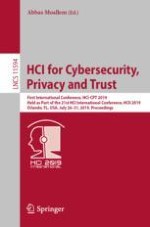2019 | OriginalPaper | Buchkapitel
Trust in Automated Software Repair
The Effects of Repair Source, Transparency, and Programmer Experience on Perceived Trustworthiness and Trust
verfasst von : Tyler J. Ryan, Gene M. Alarcon, Charles Walter, Rose Gamble, Sarah A. Jessup, August Capiola, Marc D. Pfahler
Erschienen in: HCI for Cybersecurity, Privacy and Trust
Aktivieren Sie unsere intelligente Suche, um passende Fachinhalte oder Patente zu finden.
Wählen Sie Textabschnitte aus um mit Künstlicher Intelligenz passenden Patente zu finden. powered by
Markieren Sie Textabschnitte, um KI-gestützt weitere passende Inhalte zu finden. powered by
